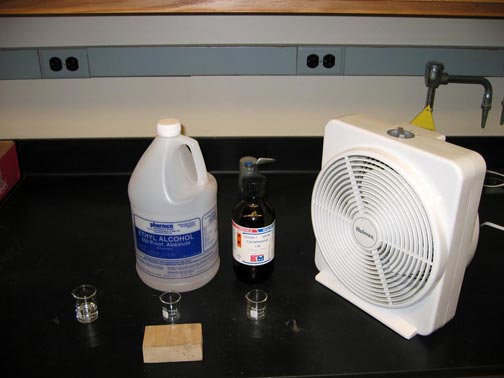Intermolecular forces and heats of vaporization
 The rate of vaporization of fixed quantities of various liquids is used as a probe of the attractive forces between the molecules of each liquid.
The rate of vaporization of fixed quantities of various liquids is used as a probe of the attractive forces between the molecules of each liquid.
Ingredients: water, ethanol, cyclohexane, fan
Procedure: A complete recipe follows.
1. Place drops of each liquid on a surface.
2. Gently blow air over the surface.
3. Observe the varying rates of vaporization of the three liquids.
Understanding: Heat must be added to a liquid to transform it into a vapor
H2O(l) → H2O(g)
When the reaction is run at constant pressure, the heat added to the system to vaporize one mole of water molecules isqP = ΔHfo[H2O(g)] - ΔHfo[H2O(l)] = -241.82 kJ -(-285.83 kJ) = 44.01 kJ
There is an energetic cost to remove a molecule of water from the liquid state and add it to the gaseous state. Therefore, the enthalpy of reaction is positive.
In our experiment, we observe that the first liquid to evaporate is cyclohexane, the second liquid to evaporate is ethanol, and water is the last to leave. In agreement with our observations, 29.9 kJ of heat must be added to one mole of cyclohexane to convert it to vapor at 25C. That is a much smaller enthalpy of reaction than in the case of water.
The heat required to convert one mole of liquid ethanol to vapor at 25C is 42.6 kJ. The enthalpy of reaction for the transformation of ethanol is greater than that for the transformation of cyclohexane, and slightly larger than that for the transformation of water. These relative heats of reaction agree well with our observations of the relative rates of vaporization of the three liquids.
Intermolecular interactions and the vaporization of liquids
Question: Explain the relative heats of vaporization in terms of intermolecular interactions.You can check your answers here.
You can check your answers here.
The heat of vaporization of water
Question:
If we look up the molar enthalpy of vaporization of water, we find that it is 40.7 kJ. That seems to be smaller than our computed heat that must be added to a mole of ethanol to convert it to vapor at 25C, 42.6 kJ. What gives?